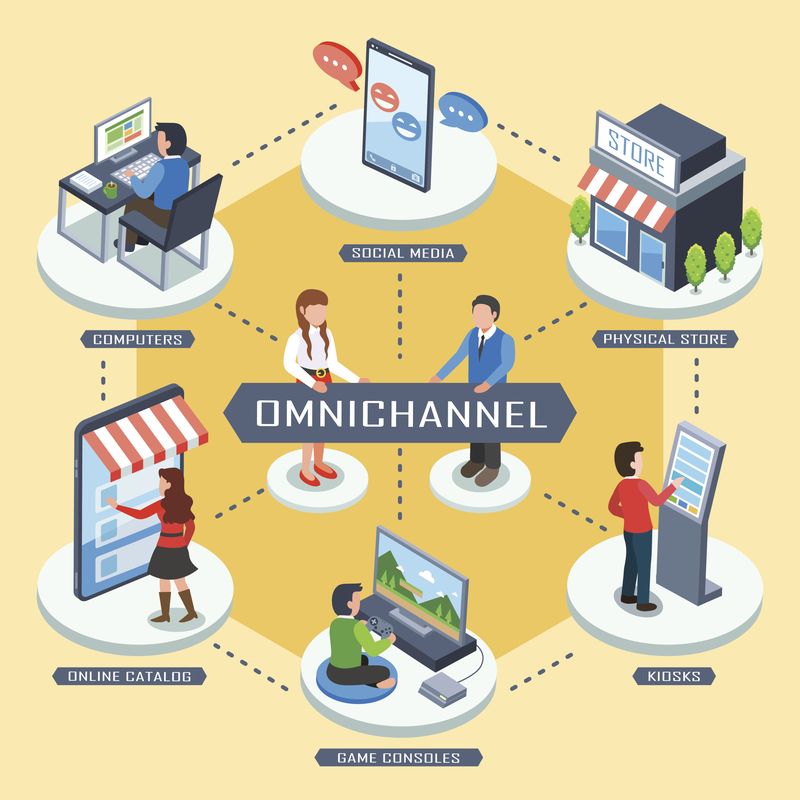Multitouchpoint-Sales & Omnichannel-Marketing with PIM
The future of retailing will be defined by a company's capability to use various distribution channels, populate these channels with useful data, and link them to each other. Regardless of the distribution channel – webshop, app, catalogue, brochure, or store – potential customers expect that providers offer a uniform shopping experience.

To this end, mobile communication plays a crucial role, because that's where customers look for detailed information about desired products, regardless of their current location. In the future, the most successful retailers will be those with the organizational and technical capabilities to synchronize their offerings across all channels. The basis for this so-called multi-touchpoint marketing is an optimized product data pool – which entails that these data come from central, consolidated and controlled data sources; and that's where Product Information Management (PIM) comes in. It takes a comprehensive PIM strategy to implement a targeted omnichannel sales strategy and achieve the corresponding added value.
Harmonization of product and customer data
In practice, selling products via a multi-channel approach often means that sales channels and the associated communication run independently of each other and in an uncoordinated way. The corresponding management staff is usually paid independently from the channel, for which they are responsible. For customers, this sometimes leads to "surreal" results:
- Existing customers are incorrectly addressed as leads (i.e., potential customers).
- Items purchased from the webshop can be returned free of charge and without further explanation; this wouldn't be possible at the store.
- Complained-about and returned products are repeatedly advertised in newsletters or flyers.
The reason for these oddities is that customer data is not held centrally and easily identifiable. The solution for these issues is the consolidated consideration of all distribution channels, and the implementation of an integrated sales and marketing strategy that puts the focus on the satisfaction of the end customer again.

This can only be achieved if the platform holding the data match their information – including central data hubs such as Master Data Management systems. The more providers implement an omnichannel strategy, the harder it will get for those market participants who do not play by these new rules of the game.
Key buying factor: optimized data quality
On this backdrop, the quality of product data is becoming ever more important, as customers can retrieve and compare products and prices at any time. If there is not enough information about a product in a webshop, they surf to the next site and end up buying it there because it simply offers better product descriptions, better pictures, and information that is generally structured in a better way. Consumers expect complete information on a product regardless of the sales context, whether at a webshop or store.
In this context, a PIM system can only serve as a technical frame; the full potential can only be exploited if a company can also ensure data quality on the staff side by aligning their systems and work processes – ideally, via a comprehensive PIM strategy so that the user can easily carry out the necessary steps.
Required: intuitive searching and finding
Due to ever-improving search options for private online shoppers, expectations of buyers in the commercial sector are on the rise. B2B is pushed by the private sector. Simple lists of products backed by the necessary basic information are no longer sufficient. Business-to-business customers are expecting more: intuitive user interfaces and features such as comprehensive filters, configurators and faceted search options (search for individual attributes).
Particularly important: also in this case, descriptive texts and other attributes have to be adapted to the target group. A text that's fine for Amazon is not necessarily so for procurement portals like Mercateo. Also, the versions for smart phones or PCs differ not only with respect to their formats, but also to the prioritization of the attributes displayed and the structure of the texts. The data maintenance and distribution processes required for this purpose in the background should be as fast, simple, and flexible as possible. This is required to ensure that data can be kept and distributed in a differentiated and targeted way.
Time-to-market: short update cycles for product data
Successfully trading goods via a webshop is determined by increasingly shorter intervals for updating product information. The reason for this are the ever-shorter life cycles of products that are often subject to seasonal demand or frequently changing fashion and media trends. To be able to keep up with the pace of this development, the systems holding the data such as Billing, ERP, CRM, PIM (Product Information Management) have to communicate with each other in an optimized way and free from redundancies. To cope with the accumulating amounts of data, it takes an intelligent system that transfers/updates only those parts of a record that actually changed (Delta). The necessary item logistics processes must be developed in a smart way and consistently implemented to ensure that product information is made available on the right distribution channel without delay.
Fully covered: the customer sales journey
You can learn a great deal from "full customer service" experts such as Apple and Amazon. They interlink devices and input and output channels without media discontinuities, and even actions can be continued seamlessly across devices and channels. For example, customers may search for a product on their smartphone, put the product in their shopping cart on the tablet, and complete the purchasing process on their desktop PC.

In the future, customers will expect this kind of full service not only on digital channels, but also in stores. The future belongs to persistent shopping carts that are synchronized via both digital and analogue channels. In a modern store environment, customers will be able to order products online directly in the store and have them sent home – for example, if a product is no longer available in the desired size. Also return and exchange processes can be done both traditionally by returning items by mail or directly at the local store.
Projektberichte
Lesen Sie diese Projektberichte über die Integration von Alterra PIM:
- Segmüller
- abholen.de von EDEKA
- Toshiba Europe
- Messer Group
- WENKO Wohnideen
- Thermokon Sensortechnik
- Halfen Group
- M+W Dental
- Stahlwille
- WASI
- Rudolf Müller Verlag
Diese international operierenden Unternehmen haben mit Hilfe von Alterra PIM erfolgreich ihr Produktdaten-Management verbessert.
Whitepaper
Contact
Sepia GmbH & Co. KG
Ernst-Gnoss-Strasse 22
D-40219 Düsseldorf - Germany
Phone: +49 211 51 419 75
Phone alternative: +49 211 74 958 712 0
E-Mail: info@sepia.de
Looking for consultation or a web demo?
Get it here.
